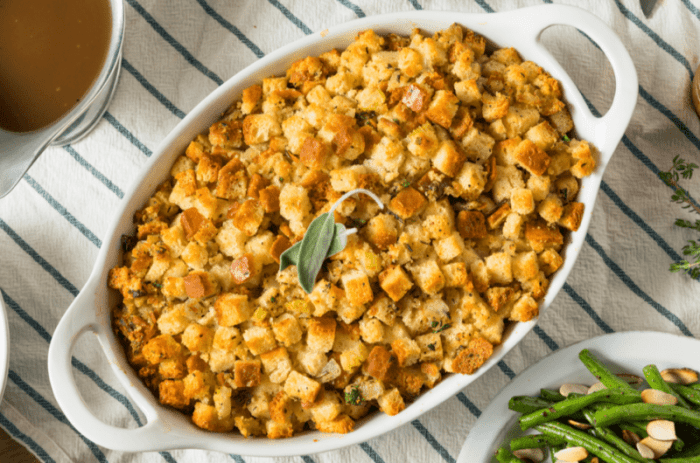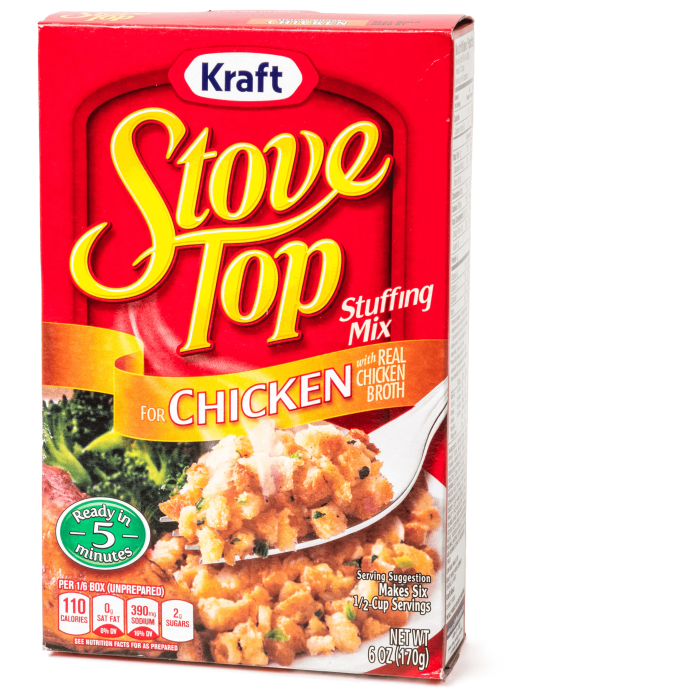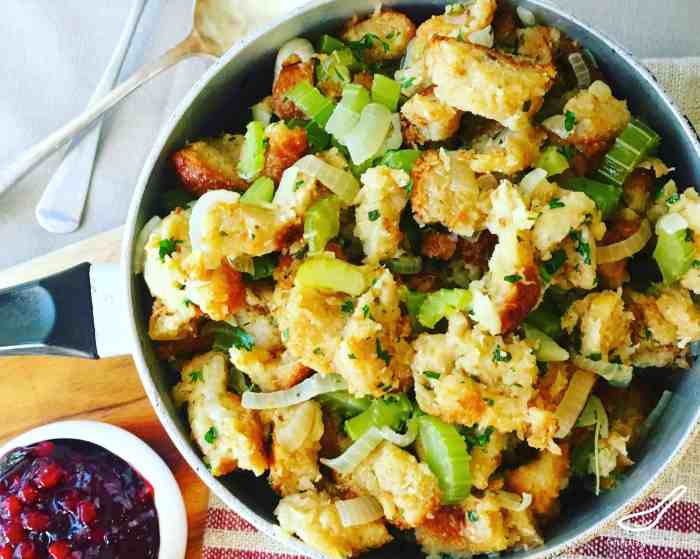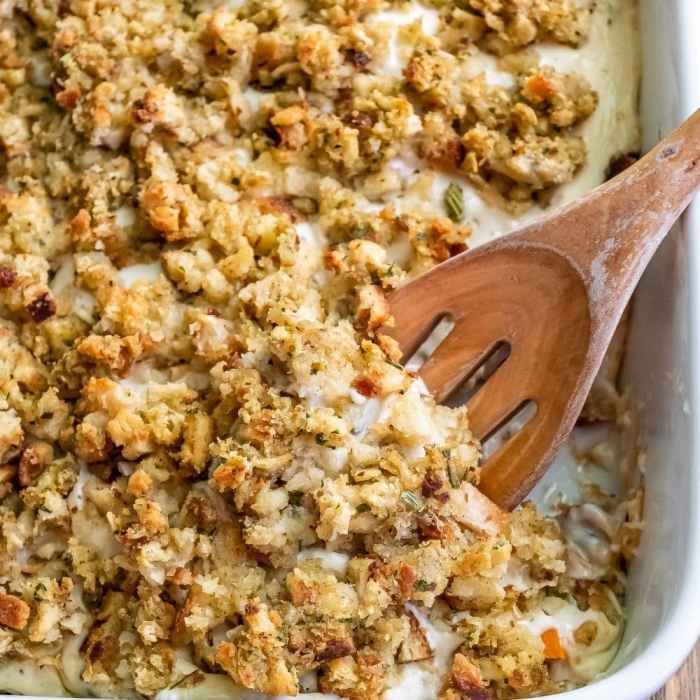Stove top stuffing recipes offer a delightful alternative to traditional oven-baked stuffing, bringing a comforting warmth and familiar flavors to any meal. This versatile dish allows for endless variations, from classic bread-based recipes to creative additions like sausage, vegetables, and global spices.
Whether you’re a seasoned cook or a novice in the kitchen, stove top stuffing is a simple and satisfying dish that can be customized to your liking.
The beauty of stove top stuffing lies in its adaptability. Unlike its oven-baked counterpart, stove top stuffing is prepared on the stovetop, allowing for a more hands-on approach and greater control over the cooking process. This method also ensures a moist and flavorful stuffing, as the ingredients simmer gently in broth or stock, creating a delicious symphony of tastes.
Introduction to Stovetop Stuffing

Stovetop stuffing is a comforting and flavorful side dish that is a staple in many kitchens. It is a versatile dish that can be made with a variety of ingredients and flavors. Unlike its oven-baked counterpart, stovetop stuffing is cooked entirely on the stovetop, resulting in a moist and flavorful dish.Stovetop stuffing is a popular choice for its ease of preparation and flexibility.
It can be made ahead of time and reheated, making it a convenient option for busy weeknights or holiday gatherings. Additionally, it is a great way to use up leftover bread, making it a budget-friendly dish.
History and Origins of Stovetop Stuffing
Stovetop stuffing has a rich history dating back to ancient times. The concept of stuffing a bird with herbs and grains is thought to have originated in ancient Rome, where it was considered a delicacy. Over the centuries, stuffing has evolved and adapted to different cultures and cuisines.In the United States, stuffing is a beloved side dish that is often served with turkey, chicken, or other roasted meats.
It is a traditional dish that is often served during Thanksgiving and Christmas. Stovetop stuffing became popular in the mid-20th century, as it offered a more convenient and quicker way to prepare the dish.
Ingredients and Variations
Stovetop stuffing is a versatile dish that can be adapted to suit various tastes and dietary preferences. The foundation of any stuffing recipe lies in a few key ingredients, but there’s plenty of room for creativity and personalization.
Common Ingredients
Here’s a breakdown of the essential components that make up a classic stovetop stuffing:
- Breadcrumbs or Bread Cubes:The base of the stuffing, providing texture and structure. You can use store-bought breadcrumbs or make your own by cubing stale bread and toasting it in the oven.
- Broth or Stock:This adds moisture and flavor to the stuffing. Chicken, vegetable, or beef broth are common choices, but you can also use a combination of broths or even wine.
- Butter or Oil:Used for sautéing the aromatics and adding richness to the stuffing.
- Celery, Onions, and Other Aromatics:These add depth of flavor and complexity to the stuffing. Consider adding garlic, shallots, or even mushrooms for a more nuanced taste.
- Herbs and Spices:The key to customizing your stuffing. Common choices include sage, thyme, rosemary, parsley, and black pepper. You can also experiment with other spices like nutmeg, paprika, or even curry powder for a global twist.
Variations in Ingredients and Flavors
The beauty of stovetop stuffing lies in its adaptability. Here are some popular variations that you can try:
- Sausage Stuffing:Add cooked sausage, such as Italian sausage or breakfast sausage, to the stuffing for a savory and meaty flavor.
- Vegetarian Stuffing:Replace sausage with vegetables like mushrooms, spinach, or even tofu for a hearty and meat-free option.
- Stuffing with Dried Fruits or Nuts:Add dried cranberries, raisins, or chopped walnuts for a sweet and crunchy contrast to the savory flavors.
- Global Flavor Variations:
- Italian:Incorporate sun-dried tomatoes, olives, and herbs like oregano and basil for a Mediterranean flair.
- Mexican:Add corn, black beans, and spices like cumin and chili powder for a Southwestern twist.
Stovetop Stuffing Techniques
Stovetop stuffing is a delicious and versatile side dish that can be customized to your liking. Unlike traditional oven-baked stuffing, stovetop stuffing is cooked on the stovetop, making it a quicker and easier option. This method also allows for greater control over the texture and consistency of the stuffing.
Sautéing Vegetables and Aromatics
Sautéing vegetables and aromatics is the first step in creating a flavorful base for your stovetop stuffing. This process adds depth and complexity to the dish.
- Start by heating oil or butter in a large pot or skillet over medium heat.
- Add your desired vegetables, such as celery, onion, and carrots, and cook until softened, about 5-7 minutes.
- Then, add aromatics like garlic, herbs, or spices, and cook for an additional minute, stirring constantly, to release their flavors.
Combining Ingredients in a Pot
Once the vegetables and aromatics are cooked, you can combine them with the remaining ingredients in a large pot.
- Add the cubed bread to the pot, followed by the broth or stock.
- Stir well to ensure all the ingredients are evenly distributed.
- Add any additional seasonings, such as salt, pepper, or poultry seasoning.
Simmering and Stirring Until Cooked
Bring the stuffing mixture to a simmer over medium heat, stirring frequently.
- Continue to simmer for about 10-15 minutes, or until the bread has absorbed most of the liquid and is tender.
- Stir occasionally to prevent sticking and ensure even cooking.
Adjusting Seasoning and Consistency
Once the stuffing is cooked, taste it and adjust the seasoning as needed.
- If the stuffing is too dry, add a little more broth or stock.
- If it’s too wet, simmer it uncovered for a few more minutes to allow the excess liquid to evaporate.
Tips and Tricks for Achieving the Perfect Texture and Flavor
There are several tips and tricks you can use to ensure your stovetop stuffing is perfect.
Using Different Types of Bread
The type of bread you use will significantly impact the texture and flavor of your stuffing.
Finish your research with information from pink drink recipe.
- For a classic stuffing, use crusty bread, such as sourdough or French bread.
- For a softer texture, use white bread or brioche.
- You can also use a combination of different breads for a more complex flavor.
Adjusting the Amount of Broth or Stock
The amount of broth or stock you use will determine the consistency of your stuffing.
- For a moist stuffing, use more broth or stock.
- For a drier stuffing, use less broth or stock.
Incorporating Herbs and Spices
Herbs and spices are essential for adding flavor to your stuffing.
- Common herbs used in stuffing include sage, thyme, rosemary, and parsley.
- Spices like poultry seasoning, black pepper, and nutmeg can also be added.
Ensuring Even Cooking
To ensure your stuffing cooks evenly, it’s essential to stir it frequently while it’s simmering.
- This will prevent sticking and ensure all the ingredients are cooked through.
- You can also use a wooden spoon to scrape the bottom of the pot to prevent the stuffing from burning.
Serving and Accompaniments

Stovetop stuffing is a versatile dish that can be enjoyed in various ways, from a classic side dish to a hearty main course. The richness of the stuffing pairs well with a variety of flavors and textures, making it a perfect complement to many meals.
Serving Suggestions, Stove top stuffing recipes
Stovetop stuffing can be served in a variety of ways, depending on your preference and the occasion.
- As a side dish for roasted meats or poultry: Stovetop stuffing is a classic accompaniment to roasted turkey, chicken, or ham. It provides a comforting and flavorful counterpoint to the savory main course.
- As a filling for stuffed vegetables or casseroles: The stuffing mixture can be used to fill bell peppers, tomatoes, mushrooms, or other vegetables. It can also be combined with other ingredients to create a hearty casserole.
- As a standalone dish: Stovetop stuffing can be served on its own as a vegetarian main course. It can be topped with gravy, cheese, or other desired ingredients.
Suitable Accompaniments
Stovetop stuffing is enhanced by a variety of accompaniments that complement its flavors and textures.
- Gravy or sauce: A rich gravy or sauce, such as turkey gravy or mushroom sauce, adds moisture and flavor to the stuffing. It also helps to create a more cohesive dish.
- Cranberry sauce: The sweet and tart flavors of cranberry sauce provide a refreshing contrast to the savory stuffing. It is a classic pairing for Thanksgiving meals.
- Green beans or other vegetables: Green beans, asparagus, or other steamed vegetables provide a healthy and flavorful addition to the stuffing. They add a touch of freshness and balance to the dish.
Recipes and Variations

Stovetop stuffing offers a delicious and versatile side dish for any meal, and there are endless variations to explore. This section provides you with a selection of recipes, including classic, sausage-infused, and vegetarian options, along with their respective ingredients, instructions, and cooking times.
Classic Stovetop Stuffing
This recipe is a timeless favorite that captures the essence of traditional stuffing.
Ingredients:
- 1 cup unsalted butter, melted
- 1 medium onion, chopped
- 2 celery stalks, chopped
- 1/2 cup chopped fresh parsley
- 1/2 teaspoon dried thyme
- 1/2 teaspoon dried sage
- 1/4 teaspoon salt
- 1/4 teaspoon black pepper
- 10 cups cubed bread (about 10 slices)
- 4 cups chicken broth
- 1/2 cup chopped fresh cranberries (optional)
Instructions:
- Preheat oven to 350°F (175°C).
- In a large skillet, melt butter over medium heat. Add onion and celery and cook until softened, about 5 minutes.
- Stir in parsley, thyme, sage, salt, and pepper. Cook for 1 minute more.
- Add bread cubes and chicken broth to the skillet. Stir to combine and let sit for 5 minutes to allow the bread to absorb the broth.
- Transfer the stuffing mixture to a greased 9×13 inch baking dish.
- Bake for 30-35 minutes, or until golden brown and heated through.
- If desired, stir in cranberries during the last 5 minutes of baking.
Cooking Time:
30-35 minutes
Serving Size:
8-10 servings
Sausage and Apple Stuffing
This recipe adds a savory and sweet twist to traditional stuffing with the addition of sausage and apples.
Ingredients:
- 1 pound Italian sausage, casings removed
- 1 medium onion, chopped
- 2 celery stalks, chopped
- 1/2 cup chopped fresh parsley
- 1/2 teaspoon dried thyme
- 1/4 teaspoon salt
- 1/4 teaspoon black pepper
- 1 medium apple, diced
- 8 cups cubed bread (about 8 slices)
- 4 cups chicken broth
Instructions:
- Preheat oven to 350°F (175°C).
- In a large skillet, cook sausage over medium heat, breaking it up with a spoon, until browned. Drain off excess fat.
- Add onion, celery, parsley, thyme, salt, and pepper to the skillet. Cook until softened, about 5 minutes.
- Stir in apple and bread cubes. Pour in chicken broth and stir to combine.
- Transfer the stuffing mixture to a greased 9×13 inch baking dish.
- Bake for 30-35 minutes, or until golden brown and heated through.
Cooking Time:
30-35 minutes
Serving Size:
6-8 servings
Vegetarian Wild Rice Stuffing
This recipe provides a hearty and flavorful stuffing option for vegetarians.
Ingredients:
- 1 cup uncooked wild rice
- 4 cups vegetable broth
- 1 medium onion, chopped
- 2 celery stalks, chopped
- 1/2 cup chopped fresh parsley
- 1/4 cup dried cranberries
- 1/4 cup chopped walnuts
- 1/4 teaspoon salt
- 1/4 teaspoon black pepper
Instructions:
- Preheat oven to 350°F (175°C).
- In a medium saucepan, combine wild rice and vegetable broth. Bring to a boil, then reduce heat to low, cover, and simmer for 45-50 minutes, or until rice is tender.
- While rice is cooking, in a large skillet, sauté onion and celery in olive oil until softened, about 5 minutes.
- Stir in parsley, cranberries, walnuts, salt, and pepper.
- Once rice is cooked, drain any excess liquid and add it to the skillet with the vegetables.
- Transfer the stuffing mixture to a greased 9×13 inch baking dish.
- Bake for 15-20 minutes, or until heated through.
Cooking Time:
1 hour 15 minutes
1 hour 20 minutes
Serving Size:
6-8 servings
Recipe Variations
- Add Mushrooms:Sauté sliced mushrooms with the onion and celery for a more earthy flavor.
- Spice it Up:Incorporate a pinch of cayenne pepper or red pepper flakes for a touch of heat.
- Add Herbs:Experiment with different herbs, such as rosemary, sage, or oregano, to enhance the flavor profile.
- Use Different Bread:Try using sourdough, rye, or even challah bread for a unique twist.
- Add Dried Fruit:Dried apricots, figs, or cherries add a sweet and chewy texture.
Tips for Success
Stovetop stuffing is a versatile dish that can be customized to your liking. With a few simple tips, you can ensure a successful stovetop stuffing experience that will please everyone at the table.
Choosing the Right Bread
The bread you choose is crucial for a good stovetop stuffing. Stale bread is the ideal choice because it absorbs the liquid without becoming mushy.
- Use day-old bread or dry it out in the oven for a few minutes to achieve the desired texture.
- Choose a variety of breads, such as white bread, wheat bread, or even rolls, for added flavor and texture.
- Avoid using fresh bread, as it will make the stuffing too soggy.
Measuring Ingredients Accurately
Accurate measuring is essential for achieving the right consistency and flavor in your stuffing.
- Use measuring cups and spoons to ensure precise measurements of all ingredients.
- Use a kitchen scale for greater accuracy, especially for dry ingredients like bread cubes and herbs.
- Over-measuring liquids can make the stuffing soggy, while under-measuring can result in a dry stuffing.
Simmering Gently and Evenly
Simmering the stuffing gently and evenly is key to achieving a perfectly cooked and flavorful dish.
- Use a low to medium heat setting on the stovetop to prevent the stuffing from burning.
- Stir the stuffing frequently to ensure even cooking and prevent sticking.
- Cover the pot with a lid to help the stuffing steam and cook evenly.
Adjusting Seasoning to Taste
Stovetop stuffing is a blank canvas for flavor. You can adjust the seasoning to your liking by adding herbs, spices, and other ingredients.
- Start with a basic seasoning of salt, pepper, and herbs, and adjust to your taste.
- Add additional herbs and spices, such as thyme, sage, rosemary, or parsley, for extra flavor.
- Experiment with different flavors, such as adding citrus zest, chopped nuts, or dried cranberries.
Storing Leftovers Properly
Leftover stovetop stuffing can be stored in the refrigerator for up to 3 days.
- Let the stuffing cool completely before storing it in an airtight container.
- Reheat the stuffing in the oven or microwave until heated through.
- Avoid storing stuffing at room temperature for extended periods, as it can spoil quickly.
Conclusion: Stove Top Stuffing Recipes

From classic comfort food to global culinary adventures, stove top stuffing recipes offer a world of possibilities. With a few key ingredients and a dash of creativity, you can create a dish that will delight your taste buds and impress your guests.
So, gather your favorite bread, spices, and aromatics, and embark on a culinary journey to discover the joy of stove top stuffing.
